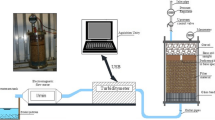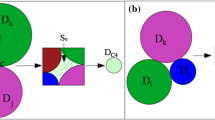Abstract
This paper presents results from a series of filtration tests to investigate geometrical and hydromechanical factors controlling the erosion of base particles and their subsequent capture into sand-gravel filters subjected to uniaxial static loading. The analysis revealed that the effectiveness of a filter, apart from its geometry (i.e. particles and constriction sizes), is also controlled by unique combinations of associated hydromechanical factors such as applied hydraulic gradients and the resulting effective stresses. Furthermore, it is observed that the base soil experiences a significant and continuous reduction in effective stress during internal flow (seepage), and the migration of base particles into the filter initiates after localised fluidisation in the base soil (i.e. at very low effective stress levels). Based on limit equilibrium considerations, a novel theoretical approach, different from all other existing methods, is proposed to estimate the critical hydraulic gradient for base soil erosion into granular filter and hence the retention capacity of filters. The current methodology is subsequently validated using experimental data from the published literature and promising results were obtained.











Similar content being viewed by others
Abbreviations
- ∆y i, δ z :
-
base particle penetration depth and elemental pore channel (mm)
- ∅′ :
-
drained angle of internal friction
- γ w and μ w :
-
viscosity (Pa.s) and unit weight of water (kN/m3)
- σ′vm, σ′vt, σ′vb :
-
mean, top and bottom vertical effective stresses respectively (kPa)
- Ɲ m :
-
dimensionless mechanical number
- d b, D cm :
-
base particle and mean constriction size of the filter media (mm)
- F d, F h, F b, F w, F f :
-
drag, hydrodynamics, buoyancy, gravity and friction forces (kN)
- F bm, F bmh, F bmr :
-
various factor of safety against base particle migration
- G s and γ s :
-
specific gravity and specific unit weight of soil (kN/m3)
- h f and h f, p :
-
filter thickness, predicted filter thickness (mm)
- h h :
-
upstream hydraulic head in dams (m)
- i cr, 0 :
-
theoretical critical hydraulic gradient for soil piping (Terzaghi 1922)
- i c0, i and i c0, t :
-
hydraulic gradient for base particle erosion under no-load condition for unit step erosion and total erosion, respectively
- i cp :
-
hydraulic gradient for base particle erosion into loaded filters
- i a and i max :
-
average and maximum applied hydraulic gradients, respectively
- i cr :
-
observed critical hydraulic gradient for particle migration into filter
- i ct :
-
theoretical hydraulic gradient for particle migration into loaded filter
- k fc :
-
contact friction factor
- n f :
-
filter porosity
- p w :
-
applied water pressure (kPa)
- q s :
-
effective overburden surcharge pressure (kPa)
- Q f, V f :
-
volumetric flow rate (lit/min), macroscopic fluid velocity (cm/s)
References
Ahlinhan MF, Achmus M (2010) Experimental investgation of critical hydraulic gradients for unstable soils. Scour and Erosion:599–608
Alobaidi I, Hoare DJ (1996) The development of pore water pressure at the subgrade-subbase interface of a highway pavement and its effect on pumping of fines. Geotext Geomembr 14(2):111–135
American Society for Testing and Materials (ASTM) (2006a) Standard test methods for maximum index density and unit weight of soils using a vibratory table. In: ASTM D4253-06. West, Conshohocken, Pa
American Society for Testing and Materials (ASTM) (2006b) Standard test methods for minimum index density and unit weight of soils and calculation of relative density. In: ASTM D4254-00. West, Conshohocken, Pa
Aziz M (2020) Using grain size to predict engineering properties of natural sands in Pakistan. Geomechanics and Engineering 22(2):165–171
Aziz M, Towhata I, Yamada S, Qureshi MU, Kawano K (2010) Water-induced granular decomposition and its effects on geotechnical properties of crushed soft rocks. Natural Hazards & Earth Sciences 10(6)
Batchelor GK (1967) An introduction to fluid dynamics. Cambridge University Press, Cambridge
Bertram GE (1940) An experimental investigation of protective filters, Soil mechanics Series No. 7. Cambridge, MA: Graduate School of Engineering, Harvard University.
Cedergren HR (1977) Seepage, drainage and flow nets. Wiley, New York
Chang D, Zhang L (2013) Critical hydraulic gradients of internal eErosion under complex stress states. J Geotech Geoenviron Eng 139(9):1454–1467
Fannin R, Moffat R (2006) Observations on internal stability of cohesionless soils. Geotechnique 56(7):497–500
Fourie AB, Copeland AM, Barrett AJ (1994) Optimization of the as-placed properties of hydraulic backfill. J South African Instt Min and Met 94(8):199–210
ICOLD (International Commission on Large Dams) (1994) Embankment dams-filters and drains. Bulletin, No. 95, Nice: ICOLD
Indraratna B, Radampola S (2002) Analysis of critical hydraulic gradient for particle movement in filtration. J Geotech Geoenviron Eng 128(4):347–350
Indraratna B, Israr J, Rujikiatkamjorn C (2015) Geometrical method for evaluating the internal instability of granular filters based on constriction size distribution. J Geotech Geoenviron Eng 141(10):04015045-1-14. https://doi.org/10.1061/(ASCE)GT.1943-5606.0001343)
Irfan M, Uchimura T (2016) Modified triaxial apparatus for determination of elastic wave velocities during infiltration tests on unsaturated soils. KSCE J Civ Eng:197–207
Israr J, Indraratna B (2017) Internal stability of granular filters under static and cyclic loading. J Geotech Geoenviron Eng ASCE 143(6):04017012. https://doi.org/10.1061/(ASCE)GT.1943-5606.0001661)
Israr J, Indraratna B (2018) Mechanical response and pore pressure generation in granular filters subjected to uniaxial cyclic loading. Can Geotech J 55:1756–1768. https://doi.org/10.1139/cgj-2017-0393
Israr J, Indraratna B, Rujikiatkamjorn C (2016) Laboratory investigation of the seepage induced response of granular soils under static and cyclic loading. Geotech Test J 39(5):795–812
Kenney TC, Lau D (1985) Internal stability of granular filters. Can Geotech J 22:215–225
Langroudi MF, Soroush A, Tabatabaie SP, Shafipour R (2013) Stress transmission in internally unstable gap-graded soils using discrete element modelling. Powder Technol 247(1):161–171
Li M, Fannin RJ 2016 Critical hydraulic gradients for internally unstable cohesionless soils. 69th Annual Canadian Geotechnical Conference, Vancouver, October
Locke M, Indraratna B, Adikari G (2001) Time-dependent particle transport through granular filters. J Geotech Geoenviron Eng 127(6):521–529
Moffat R, Fannin RJ, Garner SJ (2011) Spatial and temporal progression of internal erosion in cohesionless soil. Can Geotech J 48(3):399–412
Plagenhoef S, Evans FG, Abdelnour T (1983) Anatomical data for analyzing human motion. Res Q Exerc Sport 54:169–178
Qi Y, Indraratna B, Coop MR (2019) Predicted behavior of saturated granular waste blended with rubber crumbs. International Journal of Geomechanics 19(8):04019079
Raut AK, Indraratna B (2008) Further advancement in filtration criteria through constriction-based techniques. J Geotech Geoenviron Eng 134(6):883–887
Rice JD, Duncan JM (2010) Deformation and cracking of seepage barriers in dams due to changes in the pore pressure regime. J Geotech Geoenviron Eng 136(1):16–25
Richards KS, Reddy KR (2007) Critical appraisal of piping phenomena in earth dams. Bulletin Eng Geology Eng 66(4):381–402
Sansalone J, Kuang X, Rainieri V (2008) Permeable pavement as a hydraulic and filtration interface for urban drainage. J Irrig Drain Eng 134(5):666–674
Selig ET, Waters JM (1994) Track geotechnology and substructure management. Thomas Telford, London
Skempton AW, Brogan JM (1994) Experiments on piping in sandy gravels. Geotechnique 44(3):449–460
Smith JL, Bhatia SK (2010) Minimizing soil erosion with geosynthetic rolled erosion control products. Geo-Strata – Geo Inst 14(4):50–53
Srivastava A, Sivakumar Babu GL (2011) Analytical solutions for protective filters based on soil-retention and permeability criteria with respect to the phenomenon of soil boiling. Can Geotech J 48(6):956–969
Tanaka T, Toyokumi E (1991) Seepage failure experiments on multi layered sand columns. Soil and Foundations 31(4):13–36
Terzaghi K (1922) Failure of dam foundations by piping and means for preventing it (in German). Die Wasserkraft. Zeitschrift fur die gesamte Wasserwirtschaft 17(24):445–449
To HD, Scheuermann A (2015) Separation of grain size distribution for application of self-filtration criteria in suffusion assessment. Proc. 7th Int. Conf. Scour and Erosion (Taylor & Francis),121-127, London
Tomlinson SS, Vaid YP (2000) Seepage forces and confining pressure effects on piping erosion. Can Geotech J 37(1):1–13
Trani LDO, Indraratna B (2010) Assessment of subballast filtration under cyclic loading. J Geotech Geoenviron Eng 136(11):1519–1528
Vaughan P, Soares H (1982) Design of filters for clay cores of dams. J Geotech Eng Div 108(1):17–31
Xiao M, Shwiyhat N (2012) Experimental investigation of the effects of suffusion on physical and geomechanic characteristics of sandy soils. Geotech Test J 35(6):890–900
Xiao M, Reddi LN, Steinberg S (2006) Effect of vibrations on pore fluid distribution in porous media. Transp Porous Media 62(2):187–204
Zou Y, Chen Q, Chen X, Cui P (2013) Discrete numerical modelling of particle transport in granular filters. Comput Geotech 32(5):340–357
Acknowledgements
Supports received by the corresponding author in the form of Helan Mountain Research Scholar Program of Ningxia University China, and FDP & IPTA scholarships from University of Engineering and Technology Lahore Pakistan and University of Wollongong Australia, respectively, are acknowledged. Private discussions and consultations of the authors with the Distinguished Professor Buddhima Indraratna, previously at University of Wollongong Australia, are heartily appreciated.
Funding
This study received financial supports from Helan Research Scholar Program of Ningxia University China, Key R&D Program of Ningxia Hui Autonomous Region China (No. 2018BFH03010) and National Natural Science Foundation of China (No. 51768059).
Author information
Authors and Affiliations
Corresponding author
Ethics declarations
Conflict of interest
The authors declare that they have no competing interests.
Additional information
Responsible Editor: Zeynal Abiddin Erguler
Rights and permissions
About this article
Cite this article
Zhang, G., Israr, J. Semi empirical hydromechanical model for quantifying effectiveness of loaded granular filters. Arab J Geosci 14, 1488 (2021). https://doi.org/10.1007/s12517-021-07875-w
Received:
Accepted:
Published:
DOI: https://doi.org/10.1007/s12517-021-07875-w




